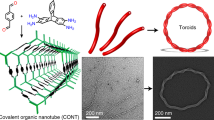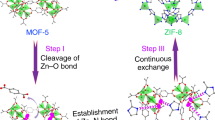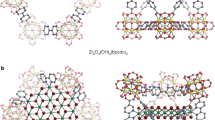Abstract
Nanotubes are generally prepared from their constituent elements at high temperatures, and thus it is difficult to control their size, shape and electronic states1,2,3,4,5,6,7,8,9,10. One useful approach for synthesizing well-defined nanostructures involves the use of building blocks such as metal ions and organic molecules11,12,13,14. Here, we show the successful creation of an assembly of infinite square prism-shaped metal–organic nanotubes obtained from the simple polymerization of a square-shaped metal–organic frame. The constituent nanotube has a one-dimensional (1D) channel with a window size of 5.9×5.9 Å2, and can adsorb water (H2O) and alcohol vapours, whereas N2 and CO2 do not adhere. It consists of four 1D covalent chains that constitute a unique electronic structure of ‘charge-density wave (CDW) quartets’ on crystallization. Moreover, exchanging structural components and guest molecules enables us to control its semiconductive bandgap. These findings demonstrate the possibility of bottom-up construction of new porous nanotubes, where their degrees of freedom in both pore space and framework can be used.
This is a preview of subscription content, access via your institution
Access options
Subscribe to this journal
Receive 12 print issues and online access
$259.00 per year
only $21.58 per issue
Buy this article
- Purchase on Springer Link
- Instant access to full article PDF
Prices may be subject to local taxes which are calculated during checkout




Similar content being viewed by others
References
Iijima, S. Helical microtubules of graphitic carbon. Nature 354, 56–58 (1991).
Hummer, G., Rasaiah, J. C. & Noworyta, J. P. Water conduction through the hydrophobic channel of a carbon nanotube. Nature 414, 188–190 (2001).
Wildöer, J. W. G. et al. Electronic structure of atomically resolved carbon nanotubes. Nature 391, 59–62 (1998).
Odom, T. W., Huang, J., Kim, P. & Lieber, C. M. Atomic structure and electronic properties of single-walled carbon nanotubes. Nature 391, 62–64 (1998).
Ishii, H. et al. Direct observation of Tomonaga–Luttinger-liquid state in carbon nanotubes at low temperatures. Nature 426, 540–544 (2003).
Chopra, N. S. et al. Boron nitride nanotubes. Science 269, 966–967 (1995).
Tenne, R., Margulis, L., Genut, M. & Hodes, G. Polyhedral and cylindrical structures of tungsten disulphide. Nature 360, 444–446 (1992).
Rosenfeld Hacohen, Y., Grunbaum, E., Tenne, R., Solan, J. & Hutchison, J. L. Cage structures and nanotubes of NiCl2 . Nature 395, 336–337 (1998).
Remskar, M. et al. Self-assembly of subnanometer-diameter single-wall MoS2 nanotubes. Science 292, 479–481 (2001).
Tang, C., Bando, Y., Golberg, D. & Ma, R. Cerium phosphate nanotubes: Synthesis, valence state, and optical properties. Angew. Chem. Int. Ed. 44, 576–579 (2005).
Fujita, M., Tominaga, M., Hori, A & Therrien, B. Coordination assemblies from a Pd(II)-cornered square complex. Acc. Chem. Res. 38, 371–380 (2005).
Yaghi, O. M. et al. Reticular synthesis and the design of new materials. Nature 423, 705–714 (2003).
Kitagawa, S., Kitaura, R. & Noro, S. Functional porous coordination polymers. Angew. Chem. Int. Ed. 43, 2334–2375 (2004).
Ferey, G. Hybrid porous solids: Past, present, future. Chem. Soc. Rev. 37, 191–214 (2008).
Fujita, M., Yazaki, J. & Ogura, K. Spectroscopic observation of self-assembly of a macrocyclic tetranuclear complex composed of Pt2+ and 4,4′-bipyridine. Chem. Lett. 20, 1031–1032 (1991).
Keller, H. J. & Martin, D. S. Jr in Extended Linear Chain Compounds vol. 1 (ed. Miller, J. S.) 357–448 (Plenum, 1982).
Kishida, K. et al. Gigantic optical nonlinearity in one-dimensional Mott–Hubbard insulators. Nature 405, 929–932 (2000).
Takaishi, S. et al. Charge-density-wave to Mott–Hubbard phase transition in quasi-one-dimensional bromo-bridged Pd compounds. J. Am. Chem. Soc. 130, 12080–12084 (2008).
Kobayashi, A. & Kitagawa, H. Mixed-valence two-legged MX-ladder complex with a pair of out-of-phase charge-density waves. J. Am. Chem. Soc. 128, 12066–12067 (2006).
Kawakami, D. et al. Halogen-bridged PtII/PtIV mixed-valence ladder compounds. Angew. Chem. Int. Ed. 45, 7214–7217 (2006).
Kimizuka, N., Lee, S. H. & Kunitake, T. Molecular dispersion of chains in the mixed-valence complexes [M(en)2][MCl2(en)2] (M: Pt, Pd, Ni) and anionic amphiphiles in organic media. Angew. Chem. Int. Ed. 39, 389–391 (2000).
Li, J. R., Kuppler, R. J. & Zhou, H. C. Selective gas adsorption and separation in metal–organic frameworks. Chem. Soc. Rev. 38, 1477–1504 (2009).
Azuma, M., Hiroi, Z., Takano, M., Ishida, K. & Kitaoka, Y. Observation of a spin gap in SrCu2O3 comprising spin-1/2 quasi-1D two-leg ladders. Phys. Rev. Lett. 73, 3463–3466 (1994).
Hiroi, Z. & Takano, M. Absence of superconductivity in the doped antiferromagnetic spin-ladder compound (La,Sr)CuO2.5 . Nature 377, 41–43 (1995).
Blumberg, G. et al. Sliding density wave in Sr14Cu24O41 ladder compounds. Science 297, 584–587 (2002).
Ozaki, M. Group theoretical analysis of the Hartree–Fock–Bogoliubov equation. I. General theory. J. Math. Phys. 26, 1514–1520 (1985).
Wakabayashi, Y. et al. Spatial correlations in the valence of metal ions in Ni1−xPdx(chxn)2Br. J. Phys. Soc. Jpn 68, 3948–3952 (1999).
Wakabayashi, Y. et al. Direct determination of low-dimensional structures: Synchrotron X-ray scattering on one-dimensional charge-ordered MMX-chain complexes. J. Am. Chem. Soc. 128, 6676–6682 (2006).
Ohara, J. & Yamamoto, S. Competing ground states of a Peierls–Hubbard nanotube. Europhys. Lett. 87, 17006 (2009).
Yamamoto, S. & Ohara, J. Optical characterization of platinum-halide ladder compounds. Phys. Rev. B 76, 235116 (2007).
Acknowledgements
Synchrotron XRPD and diffuse X-ray scattering measurements were supported by High Energy Accelerator Research Organization (KEK), Japan (Proposal no. 2008G068). Synchrotron XAFS measurements were supported by Japan Synchrotron Radiation Research Institute (JASRI) (Proposal no. 2010B1975). This work was partly supported by Research Fellowships for Young Scientists (No. 1910614) from the JSPS. H.O. is grateful for support by a Grant-in-Aid for Scientific Research (No. 20110005) by the Ministry of Education, Culture, Sports, Science and Technology of Japan.
Author information
Authors and Affiliations
Contributions
H.K. and K.O. designed and directed this study, and analysed the experimental results. K.O. contributed to all of the experimental work. Y.W. carried out synchrotron diffuse X-ray scattering measurements. J.O. and S.Y. conducted theoretical calculations. H.M. and H.O. contributed to single-crystal reflectance spectroscopy. K.N. and T.U. carried out synchrotron XAFS measurements. K.O., Y.W., J.O., S.Y. and H.K. co-wrote the manuscript. All authors commented on the paper.
Corresponding authors
Ethics declarations
Competing interests
The authors declare no competing financial interests.
Supplementary information
Supplementary Information
Supplementary Information (PDF 6119 kb)
Rights and permissions
About this article
Cite this article
Otsubo, K., Wakabayashi, Y., Ohara, J. et al. Bottom-up realization of a porous metal–organic nanotubular assembly. Nature Mater 10, 291–295 (2011). https://doi.org/10.1038/nmat2963
Received:
Accepted:
Published:
Issue Date:
DOI: https://doi.org/10.1038/nmat2963
This article is cited by
-
A chalcogenide-cluster-based semiconducting nanotube array with oriented photoconductive behavior
Nature Communications (2021)
-
Confined water-mediated high proton conduction in hydrophobic channel of a synthetic nanotube
Nature Communications (2020)
-
Different carboxylic acid homodimers in self-assemblies of adducts of 3-carboxyphenoxyacetic acid with nitrogen containing compounds
Journal of Chemical Sciences (2016)
-
Porous materials with pre-designed single-molecule traps for CO2 selective adsorption
Nature Communications (2013)
-
Nanotubes: Bottom-up control
NPG Asia Materials (2011)



